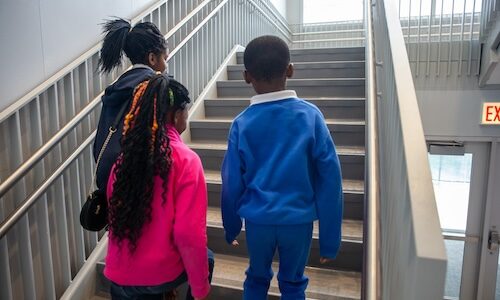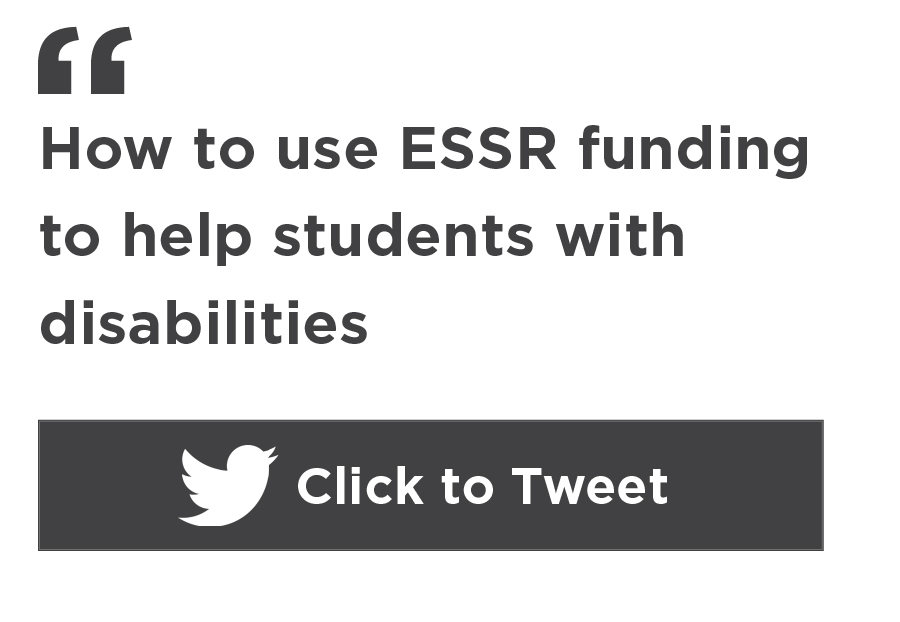As the pandemic continues to reverberate throughout our education system, schools find themselves with both unprecedented challenges and rare, potentially transformative opportunities for renewal. With respect to the tough road ahead, the prolonged absence of students from the classroom has led to interrupted learning and social-emotional challenges—and, as is so often the case, the impact has fallen disproportionately on marginalized groups, such as students with disabilities.
However, a massive influx of COVID-19 recovery funding from Congress has introduced the tantalizing possibility that a long-held vision of more equitable, inclusive access to education may be closer to becoming reality than at any time in recent memory. With $122.8 billion set aside for the Elementary and Secondary School Emergency Relief (ESSER) Fund and $3 billion for the Individuals with Disabilities Education Act (IDEA), Congress is betting that districts and schools can do big things on behalf of students, if given the chance.
As states, districts, and schools begin planning how to spend this relief funding, they’ll benefit from guidance to ensure that their investments lead to high-impact, enduring changes. The National Center for Learning Disabilities (NCLD) is helping to shape this conversation with a newly released set of recommendations, “Investing in lasting change: How states and districts can use recovery funds to support students with disabilities.”
Students with disabilities can achieve just as highly as everyone else—if not more highly!—and it’s time to ensure that our system provides the supports they need.
In developing its report, the NCLD partnered with the Policy & Advocacy and Research teams at NWEA, as well as the Alliance for Excellent Education, and was able to leverage new NWEA research on how students with disabilities fare during periods of interrupted learning. Together we presented a recent webinar, “Supporting COVID-19 recovery for students with disabilities: Research findings, policy recommendations, and lessons from the ground,” now available for on-demand viewing.
To learn more about this research and NWEA’s partnership with NCLD, I chatted with Elizabeth Barker, accessibility research manager with the NWEA Collaborative for Student Growth, and Meghan Whittaker, director of policy and advocacy at NCLD. Their answers have been edited for length and clarity.
How did the partnership between NWEA and NCLD evolve?
Meghan: I was already familiar with NWEA’s learning assessments for students with disabilities, but I was really glad when I learned about the data they were gathering specifically related to the growth of students with disabilities. When we talked about their latest research, I found a great deal of alignment between their research findings and our policy priorities. As an organization dedicated to improving the lives of students with learning and attention issues, we were able to give NWEA some validation about how crucial their data was to our work. In turn, NWEA gave us high-quality data that validates what we’ve always known but didn’t always have data to prove: Students with disabilities can achieve just as highly as everyone else—if not more highly!—and it’s time to ensure that our system provides the supports they need.
The NWEA study looked at differential growth during school years and summers for students in special education. What prompted this research?
Elizabeth: NWEA’s growth research database contains a unique and very large set of anonymized assessment data within and across school years, so it lends itself well to rigorous research. But there hasn’t been much research about how seasonal learning patterns affect the academic growth of special education students specifically. We wanted to examine this question, in the hopes of distinguishing the reality from some of the common beliefs we might have about students with disabilities that aren’t based on evidence.
What were your overall findings? Were there any surprises?
Elizabeth: We found that students who had ever been enrolled in special education entered kindergarten at an academic disadvantage relative to their non–special education peers, and we found that students in special education lost more learning during each summer. However, we also found that during the school year, students with disabilities grew academically just as much as—if not more than—students without disabilities. For me, that’s a big takeaway. There’s so much pressure to improve growth, and certainly a lot of work remains to be done, but there are already great things happening for students with disabilities. For teachers, parents, students, and families, there are successes to celebrate.
What are the implications of this research for students with disabilities?
Meghan: For a long time, our system has held students with disabilities to different standards from other students, assuming that they have less potential to learn and grow as learners. This research proves that they can and do grow at the same or higher rates than other students. They are just as capable! We have known that the instruction that works for students with disabilities works for everyone. If you have a solid, evidence-based practice, it will lift all learners. However, while students with disabilities are often just as capable as everyone else, the research shows that they can experience bigger losses over the summer or other periods when they’re not in school. We need to do more than help them catch up; we ought to be ambitious and push them further ahead. But before we can do that, we have to believe in their potential—and the research gives us every reason to do so.
What’s behind the larger summer losses for students with disabilities?
Elizabeth: That was definitely an interesting finding! Unfortunately, our data doesn’t include information on what services or supports students received over summers, or what kinds of disabilities these students have. Both of those can vary widely, both for different students and in different schools. One possibility is that without the repetition and reminders provided by continuous education, students who struggle with retention of learning and memory may have challenges. At this point, though, we’re just speculating. We need more research to understand the causes better.
How does the disruption of the pandemic fit into this research?
Elizabeth: The observation period for this study predates the pandemic, but what we’re showing is that summer is a break in the continuity of learning and can lead to a loss of opportunity to learn. In that sense, summer serves as a proxy for any extended period of absence from school. It’s reasonable to assume that for students with disabilities, some of the disruptions of the pandemic—families moving, economic hardship, schools not being able to deliver certain interventions—create an even more urgent need for adequate support.
What does the new funding from Congress mean for students with disabilities?
Meghan: There’s a lot of discussion these days about the pandemic and how hard it’s been for students and their families, especially around interrupted learning and growing opportunity gaps, often called achievement gaps. But those gaps aren’t new for marginalized populations, whether it’s students with disabilities, students of color, or students from low-income families. These gaps have always been with us, but now that all students have experienced hardship, the political will to invest heavily in education is unlike anything we’ve seen before. Our hope is that with this major influx of federal funding to address instructional loss, we can finally begin to close these longstanding gaps for good.
How did NCLD develop its recommendations for the best ways to invest these recovery funds?
Meghan: We structured our recommendations to respond specifically to the challenges we see facing our students with disabilities, including academic achievement, social-emotional development, and family supports. We identified four areas of focus:
- High-quality, accessible, and inclusive academic instruction
- Inclusive and culturally responsive social-emotional learning
- Effective progress monitoring and accurate evaluations for specialized instruction
- Meaningful family support and engagement
Each of these areas is worth pursuing on its own, but taken together, they’re an integrated strategy that can make a big difference for students with disabilities. States, districts, and schools can begin the process by getting an accurate baseline of where their students are at, assessing the gaps, and getting high-quality instruction in front of them. At the same time, we all need to recognize that no student will learn effectively if we don’t tend to their social-emotional needs and recognize all the loss they’ve experienced in the last year.
Once these steps have been taken and the necessary supports are in place, schools can more accurately evaluate student needs. Some may need special education, but others may simply be recovering from the stress of reintegrating and catching up after the interruption in their education. Finally, schools can take a close look at the role of families and how best to engage them, so that the education of our students with disabilities is a truly collaborative effort.
Now that the study is out and the recommendations have been released, what’s next?
Meghan: Our short-term goal is to put these recommendations in front of the right people and continue offering guidance. States are in the process of submitting their plans for how they’ll spend their relief funding, and they’re engaged in a lot of iterative work around that. They may not know quite where to begin investing their federal funding. New technologies? New vendors? Some states or districts may feel they are grasping at straws. Our hope is to guide them in the direction of the most impactful changes for students with disabilities. Throughout our report, we point to additional resources and places to go for more ideas. As states refine their plans over the next couple of years of using their funds, we want them to have the best direction to make wise investments.









